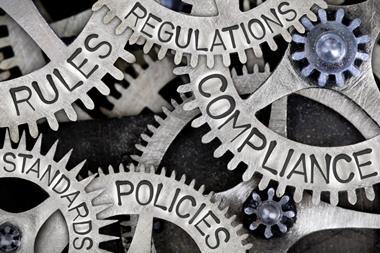Last month saw the publication of a new corporate governance risk map Sue Copeman writes.
It is over two years since the World Economic Forum (WEF) announced its 'global corporate governance dialogue' initiative. WEF, which sees corporate governance as one of the top 10 risks for the coming year, continues to focus on improving the quality and coordination of corporate governance frameworks around the world.
As part of this initiative, the Forum commissioned Maplecroft to produce an interactive corporate governance risk map. This was launched on 25 January in time for the WEF annual meeting of business leaders. It features, among other things, a corporate governance index which measures risks to corporate governance in 132 countries.
So how does Maplecroft - a network of academics and practitioners in the field of corporate responsibility - define corporate governance, and what does the map tell us?
Maplecroft has a two part definition. 'Corporate governance is firstly the means by which a corporation is directed and controlled to achieve corporate performance. Sound corporate governance has been associated with superior creation of shareholder value. Secondly, corporate governance is the means by which the risks inherent in the separation of ownership and management are managed to ensure that shareholders' interests do not receive a lower priority than those of the managers.'
The picture of corporate governance performance revealed by Maplecroft's corporate governance index highlights the danger of making assumptions based on a rich country/poor country divide. Similarly, legislation alone is no guarantee of good governance; much depends on how rigorously and successfully laws are enforced.
The index attempts to address this through the inclusion of perception indicators of corporate governance and corruption.
The best score is achieved by New Zealand, followed by Singapore and the UK. While it is hardly surprising that the worst scorer is Afghanistan, more disturbing is the fact that within the European Union, it is Greece rather than the newly acceded countries that provides the greatest challenges to investors. And Italy - ranked 69 - is also in the lower half of the score card.
Maplecroft says that some business groups have begun to rebel against the post-Enron consensus on the need for rigorous adoption and enforcement of tighter corporate governance standards. Criticism focuses on the extra cost burden. It also notes a backlash against increasing expectations for better governance of environmental and social risks. However, these counter factors have made little difference to political pressure for higher standards. 'Responsible investment approaches that integrate environmental, social and governance risks are inching into the mainstream, led by the slow advance of requirements on pension funds for statements of investment principles,' comments Maplecroft
Key business risks
With the launch of the map, Maplecroft has also identified what it sees as the principal risks which poor corporate governance may exacerbate.
- UNDERPERFORMANCE: Some research supports the proposition that corporate governance is a key to unlocking superior corporate value.
- FINANCIAL DISTRESS: Poor financial oversight can result in a difference between market understanding of the value of, and risks faced by, a corporation, and the real value and risks. When the difference comes to light, the correction can include substantial share price devaluation and poorer credit risk ratings, or in the worst case insolvency.
- REGULATORY ENFORCEMENT: Irregular accounting practices, abusive executive pay practices and the failure to provide adequate or accurate disclosure of risks, have resulted in substantial regulatory financial penalties and expensive mandated corrective action.
- POLITICAL DAMAGE: Where self-regulation has evidently failed, serious issues may damage relationships with shareholders and other stakeholders.
It can also trigger activist resolutions, or tight new regulation that may not represent the most-cost effective method of avoiding corporate governance risks. Firms subject to the Sarbanes-Oxley Act have encountered substantial compliance and audit costs as a result, although the SEC maintains that this is in large part due to a failure to implement the Act's requirements in a moderate, planned and focused way.
Maplecroft points out that there are also risks for individuals involved in poor governance. 'Increasing personal accountability means that failures can result in damage to an individual's reputation, but also in lost bonuses, personal fines, employment bans and ultimately imprisonment. Innocent and competent workers of a firm facing a substantial governance failure can find themselves made redundant.'
Corporate governance, like corporate social responsibility, is not an easy thing to measure. The group admits that there are limitations to its study. The index does not encompass all aspects of corporate governance but focuses on those relating to self-dealing. The data is probably skewed towards litigation as a means of investor protection, largely to the benefit of the USA in the range of countries covered. The index also does not measure the extent of the inclusion of non-financial interests (the social and environmental concerns of stakeholders beyond shareholders) in corporate decision-making, even though this is becoming a critical concern of corporate governance analysts.
Despite these limitations, the index is probably one of the most meaningful ways currently available of identifying countries experiencing low levels of corporate governance performance.
Sue Copeman is editor, StrategicRISK
GLOBAL MAP OF CORPORATE GOVERNANCE
Features of the map include:
- Risk analysis - a corporate governance index that measures risks to corporate governance in 132 countries
- Analysis of the wider issue of corporate governance and specific risk implications for business and other stakeholders
- Hotspots identifying countries where low standards of corporate governance are especially significant
- Spotlights describing examples of attempts by business, governments or regulators to improve corporate governance standards
- Flashpoints profiling examples of serious corporate governance related incidents
- Access to Transparency International's daily corruption news.
The map is available online at maps.maplecroft.com/governance.



















